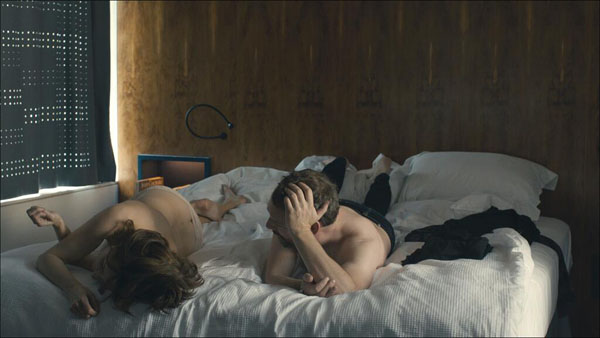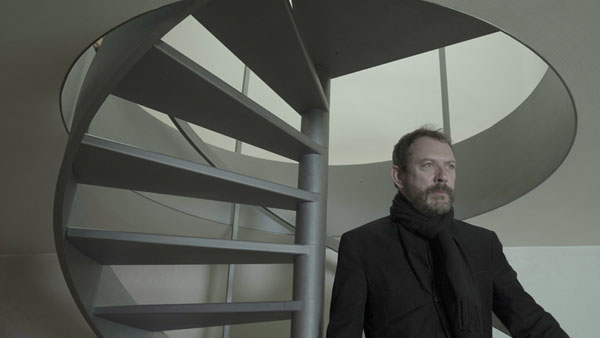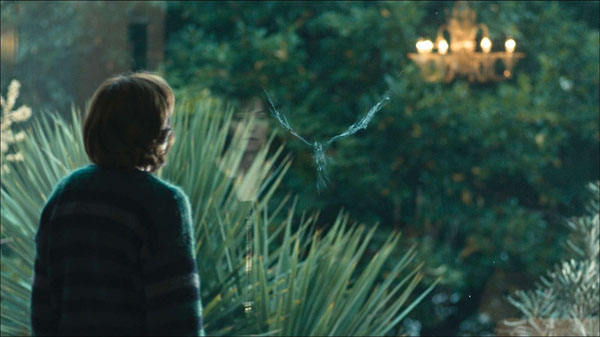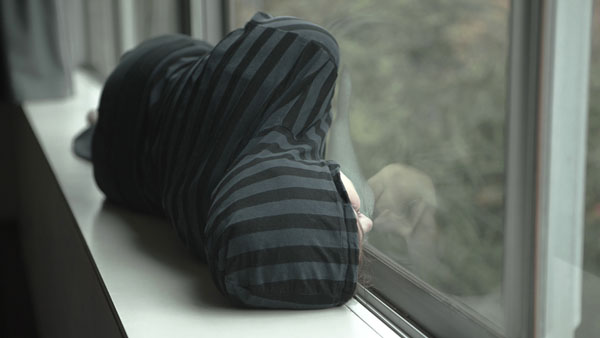“In the space of two films,” begins Ryan Gilbey in the Guardian, “the 53-year-old British writer-director Joanna Hogg has already carved out a distinctive niche for herself. Her 2007 debut, Unrelated, winner of the Guardian First Film award, documented forensically the seething tensions among the middle-class holidaying in Italy. Its follow-up, Archipelago (which counts Martin Scorsese among its fans), documented forensically the seething tensions among the middle-class holidaying in the Scilly Isles. But her new film, Exhibition, is a bold departure: no one goes on holiday…. The picture takes place almost entirely in an exquisite modernist house in west London designed by, and formerly home to, the late architect James Melvin (to whom Exhibition is dedicated). Two artists, listed in the credits only as D [Viv Albertine, former guitarist for The Slits] and H [conceptual artist Liam Gillick], live here…. We may not know what lies in store for D and H at the end of Exhibition, but Hogg’s future as one of the most compassionate portraitists of the British psyche is assured.”
“[S]omething in [D and H’s] past has left both of them unquiet,” writes the Telegraph‘s Robbie Collin. “Hogg withholds the specifics, but two topics keep blowing through the film like mist: the absence of children from their lives and the danger of the city streets at night.” The “fish-tank windows” of the house “remind you of the apartments stacked like televisions in Jacques Tati’s Playtime, but Hogg plays games with their glassy surfaces, nesting reflections inside reflections to the point where we can no longer tell if the camera is indoors or out…. Hogg’s film is alive with anxiety, with scenes that rattle your nerves like stones in a tin.”
Kate Muir‘s review for the Times is behind a paywall, but non-subscribers can see that she’s given Exhibition five out of five stars.
Updates: “Mostly filmed in static shots, Exhibition is a visual delight, framed in precisely composed close-ups of the house both inside and out,” writes Stephen Dalton in the Hollywood Reporter. “Fans of Hogg’s previous films may also relish the in-joke cameo by her former leading man Tom Hiddleston, who appears fleetingly as a smooth-talking real estate agent. But the core drama feels underpowered, serving up two well-drawn characters but doing very little with them. There are teasing hints here of a Michael Haneke-style thriller about urban paranoia, or a Mike Leigh-style treatise on class-ridden Britain. But the episodic script ultimately proves to be more still life than dynamic narrative.”
“Exhibition is a chilly, thoughtful and gently striking film that likely deserves a second viewing to pick up on the gently provocative and subtly amusing moments that Joanna Hogg deftly layers into her film,” writes Screen‘s Mark Adams.
For Variety‘s Justin Chang, “the whole thing teeters between very boring and completely fascinating, like being stuck on a plane in business-class seats next to a bickering couple you can’t stop eavesdropping on…. It’s annoying, especially to women viewers, that every time a female actor over the age of 40 takes her clothes off in a film she’s called brave, but Albertine’s willingness to expose herself here, physically and emotionally, is nevertheless impressive… Albertine deserves kudos, as does Gillick and above all Hogg, whose skill at coaxing spontaneous performances from semi-improvised dialogue has never been better showcased than it is here. Audiences will never be in doubt that she and her cast members know these people from the inside out.”
Updates, 8/11: “D’s time spent on her own illuminates her alienation even as she never puts it into words,” writes Indiewire‘s Eric Kohn. “Capricious but never quite twee, her solo antics are a simultaneously odd and believable representation of the way behavior illuminates deep thoughts. It’s easy enough to view the character in the tradition of Miranda July’s comically sad antics, only far stranger; D hovers in a dreamlike condition through a much bigger world.”
“Beyond the exploration of gender roles—so pronounced, particularly in the bedroom, as to make it seem as though D and H could stand for ‘Dame’ und ‘Herr’—Hogg retains the focus on class that characterized her earlier works,” writes Ronan Doyle at Next Projection. “There’s a barbed irony to the faux-bohemianism of D and H, the idyllic life as symbolised by this striking structure gradually exposed for the hollow show it is.”
Michael Pattison interviews Hogg for the festival.
Update, 8/20: “Without the clear linear crescendo of Hogg’s previous films, a climactic screaming match of the kind seen in Unrelated and Archipelago could not be in the cards,” writes James Berclaz-Lewis for Filmlinc Daily. “Indeed, Exhibition’s fragmented aesthetic required a redesign of that moment of cathartic release. With that in mind, the British director combines D’s affinity with performance art with what appears to be something approximating a dream sequence. D & H sit next to each other against a white backdrop, illuminated by a bright, off-screen spotlight. These visual cues suggest an interview in front of an unseen and unheard audience…. While superficially unsatisfying, the unusual scene is an astounding example of Hogg’s attention to the unity of her work with regard to form, and consequently of her ability to evolve and adapt her writing and directing to fit the needs of how she addresses her subject matter.”
Update, 8/29: “Fixed-camera compositions emphasize both the emotional disconnect and the sense of claustrophobia of a marriage on the decline,” writes Michael Pattison at Filmlinc Daily. “New to Hogg’s visual vocabulary are those high- and low-angle shots, in which one character observes another. The framing appears like some violently declarative gesture, and emphasizes the unacknowledged hierarchy that defines how the couple relate to one another.”
Update, 12/1: “As a horror concerned with the murky psychological corners of bourgeois lives, Exhibition is a great success,” writes Benedict Morrison in the Oxonian Review. “The very textures and form of the film contribute its intimations of violence, while the story, as should be the case in more horror films, allows meandering ambiguity to speak of unspoken nightmares. (highlightszote.com) The film’s quiet disquiet is terrible; the naturalistic soundscape of sirens, of sliding doors, of steps on stairways is devastating. For a moment, as a cake in the shape of the house is cut, symbolically demolishing the place which is as much a prison as a retreat, the reflections in the windows disappear; the glass becomes clear, hopeful. Silent shots of plants in the garden are offered in a startling, and startlingly beautiful, pink-washed monochrome. But these images are a momentary relief and the reflections return. This is a horror without resolution and, as a result, all the more terrifying.”
Locarno 2013 Index. For news and tips throughout the day every day, follow @KeyframeDaily on Twitter and/or the RSS feed. Get Keyframe Daily in your inbox by signing in at fandor.com/daily.







